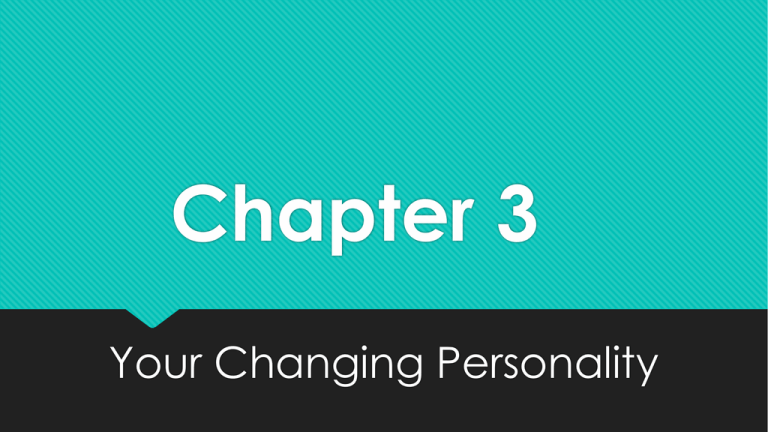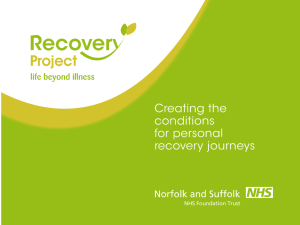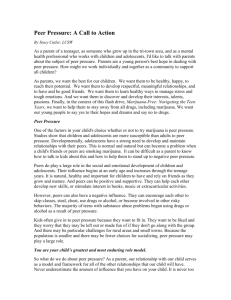Chapter 3 ppt
advertisement

Chapter 3 Your Changing Personality Section 1: Life’s Stages and Human Needs What do you think? One of the most important tasks of the teen years is to work out an individual identity. Human beings need the respect of others even more than they need shelter People who imagine themselves as more successful than they are need to stop dreaming. Section 1: Life’s Stages and Human Needs Erikson’s Eight Stages of Life Psychologist Erik Erikson has developed a theory that states people move through eight stages in the course of their lives. In each stage they learn important things about themselves and the world. Erikson’s Eight Stages of Life 1. Infancy (0-1) 2. Toddler Stage (1-2) 3. Preschool Age (3-5) 4. School Age (6-12) 5. Adolescence (13-20) 6. Young Adulthood (21-40) 7. Adulthood (41-60) 8. Older Adulthood (61 and older) A Teen’s New Experiences New Ideas and New Groups Teens try out new ideas, develop new words, and give meaning to old phrases as they use their imaginations to explore and search for their identities. New Ways of Thinking Teens begin to think in abstract terms. Teens consider variables (changeable factors that affect outcomes) and use logic to make predictions of what might happen New Emotions Many teens will feel the ups and downs of different emotions Human Needs According to Maslow Erickson saw life’s tasks associated with age groups, however Maslow described them as a hierarchy (a ranking system in which each thing is placed above or below others) It is considered a ladder of human needs that people of all ages experience at different times Maslow linked these needs to life’s accomplishments Maslow also believed people will first try to meet their basic needs before they can begin to think about “higher needs” Section 2: Gender and Personality Physical Maturation Adolescence is a time of rapid physical growth and mental change The beginning of adolescence is marked by puberty (the period of life in which a person becomes physically capable of reproduction) The Adolescent Growth Spurt Girls: intensive growth spurt by age 10 or 11 Boys: intensive growth spurt by age 12 or 13 Gender Identity Your personality is affected by your gender-the classification of being male or female The male or female roles people play are known as their gender roles, roles assigned by society to people of each gender. The parts of the male or female role that a person adopts and lives by becomes that person’s gender identity, that part of a person’s self-image that is determined by the person’s gender. What if the roles don’t fit? People are individuals. Roles that fit one person perfectly may not fit another. If everyone accepted roles without question, societies would never change. However we have stereotypes and these do not recognize one’s individuality and may harm individual development. Section 3: Developing Self-Esteem People who know and like themselves are emotionally healthy Not only do they have a strong sense of self-efficacy for accomplishing tasks, but they also have high self-esteem (the value a person attaches to his or her self-image) Many factors can benefit your self-image Friends who value and respect you Regular physical activity Being involved in community activities You give yourself the power to become the person you want to become and to do the things you want to do when positive ideas replace selfdefeating messages 10 Ways to Improve Self-Esteem 1. Write positive statements about yourself 2. Find activities related to your goals 3. Be grateful for what you have 4. Practice positive self-talk 5. Search for books and movies with positive themes 6. Find friends who believe in you 7. Support others/ be a positive friend 8. Refuse to think negatively about yourself and others 9. Celebrate your successes 10. Give and receive appropriate affection Section 4: The Importance of Peer Groups A peer group is simply a group of friends similar to yourself in age and stage of life Peer groups can be positive (influence on development) or negative (peer pressure or cliques) to adolescents Most peer groups, though, provide their members with a sense of belonging A circle of friends offers a place to share ideas, interest, and opinions. These friends also provide support and strength The Value of Peer Groups Peer groups can help teens feel a sense of belonging An important function of peer groups is to help lessen teen’s natural fears Peer groups provide shelter and comfort from within Peer groups also help teens through tough times, as it is natural to share feelings with others. Negative Peer Groups Cliques A peer group that rejects newcomers and judges both their members and nonmembers harshly Cults Groups of people who share intense admiration or adoration or a particular person or principle Gangs Groups that exist largely to express aggression against other groups PEERS ARE IMPORTANT, MAKE SURE YOU CHOOSE THEM WITH CARE!







